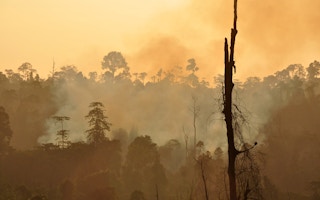Indonesia’s forest fires have made headlines globally over the past few weeks. This year’s forest fires have affected millions of people. Schools have closed in some areas due to unsafe levels of air pollution, while many people are suffering from respiratory illnesses. The haze has spread so far as to affect Singapore and Malaysia.
While forest fires are cyclical, typically occurring in Indonesia every year from July through October, this year’s season is the worst since 2015, when fires resulted in $16 billion in economic losses and spewed more greenhouse gas emissions daily than the entire U.S. economy. The fires — most of which have been set intentionally to clear land — threaten to derail progress Indonesia has made in curbing its deforestation in recent years.
Here’s a deeper look:
1. 2019’s fires are the worst since 2015.
According to data displayed on Global Forest Watch (GFW) Fires, there have been 66,000 fire alerts from January through the end of September. While this is much lower than fire levels in 2015 — which saw more than 110,000 alerts at the end of September — it far exceeds forest fires levels in 2016, 2017 and 2018.
2. This year’s fires jeopardise Indonesia’s progress in reducing deforestation.
Of the countries historically most responsible for the world’s deforestation, Indonesia is the only one that’s actually reduced its deforestation rate in recent years. This year’s fires season could derail this promising trend.
According to annual tree cover loss data on Global Forest Watch, Indonesia’s deforestation rate declined significantly in 2017 and 2018, after a record-high in 2016. National policies like the forest moratorium and peatland restoration plan played a big role, but these years also benefited from wetter conditions associated with the La Niña weather pattern.
While farmers set fires every year to clear land, the blazes are less likely to spread or rage out of control during wet years than they are during dry years. With the return of El Niño this year and its warmer, drier conditions, it’s unclear if Indonesia will see further declines in deforestation this year. We’ll need to wait until Global Forest Watch’s 2019 tree cover loss data is available to measure fires’ full impact on the country’s forests.
3. 42 per cent of fires have occurred in peatlands
Data on GFW Fires shows that 42 per cent of fire alerts detected in Indonesia this year occurred in peatlands, just like in 2015 where 40 per cent of fires were observed on peatland.
Fires on carbon-rich peatlands are notoriously difficult to extinguish. Organic matter inside peat makes fires bigger and generates more haze. Burning peatland is also problematic for the climate — draining one hectare of tropical peatland will produce an average of 55 metric tonnes of carbon dioxide per year, the equivalent of burning more than 6,000 gallons of gas.
4. Central Kalimantan and West Kalimantan are experiencing the most fire alerts.
The provinces of Central Kalimantan and West Kalimantan have seen the most fire alerts in 2019, followed by Riau, Jambi and South Sumatra. Within those provinces, Ketapang regency in West Kalimantan and Pulang Pisau regency in Central Kalimantan experienced more fire alerts than any other areas of Indonesia — just like they did in 2015.
Ketapang is the biggest regency in West Kalimantan, and an area where the expansion of oil palm plantations has resulted in significant tree cover loss. Pulang Pisau regency is very vulnerable during the dry season because its geological structure is dominated by drained peatland. The government’s Mega Rice Project of the mid-1990s sought to convert 1 million hectares of peatlands into rice plantations. The program has since been abandoned because the land proved unsuitable for massive rice cultivation.
What can we do?
The fact that fires are still a far cry from the levels seen in 2015, the last time the country experienced an El Niño weather pattern, shows an improvement in the government’s effort to tackle forest and peatland fires. However, experts agree that more efforts to reduce forest fires and haze are required, and the country still could go further in preventing forest fires. Three actions could help:
-
Restore peatlands.
Peat swamps are normally moist year-round, unless they’re drained for agriculture. The risk of fires increases when peatland is dried. A small fire could trigger huge fires on peatland — not only horizontally across the landscape, but also vertically, up to 4 meters below the surface. Even if the top of peatland is free from fires, fires below could survive for months and spread to other areas.
Rewetting degraded peatlands — by blocking canals, digging wells and more — will increase peat’s water levels over time, potentially slowing down the spread of fires. Comprehensive peatland restoration should also include mapping, restoration planning, revegetation, and revitalising communities in the surrounding areas so that they will not need to drain peatland again to support agriculture.
-
Incentivise non-burning land-clearing methods.
According to Indonesia’s National Disaster Management Agency (BNPB), the majority of the country’s forest fires are caused by humans, both intentionally and unintentionally. Fires are usually caused by land clearing for plantations using slash-and-burn methods. Even though the punishment for such methods could be up to 12 years in prison or a 10 billion rupiah fine (more than $700,000), slash-and-burn continues because it’s seen as the easiest and cheapest method to clear land.
Banning the practice without a readily accessible alternative is ineffective. In past years, the Indonesian government has disseminated to farmers and companies information about non-burning methods, such as using heavy equipment and biological materials, or cultivating plants that can be grown without draining peatland. But these solutions alone are not enough for people to shift their habits, BNPB admitted, especially since some of them are expensive or unfamiliar to farmers.
-
The agency asked the Technology Assessment and Application Agency (BPPT) for help in finding other methods. BPPT is currently developing biopeat fertiliser technology, a method to improve peatlands’ fertility, to prevent slash-and-burn practices. The fertiliser has been tested in a company plantation in Riau since 2017, but it hasn’t been massively produced. More time and investment will be required to determine whether this method could be a mainstream approach for farmers.
All sectors, including NGOs and civil society, can participate in identifying, popularising and incentivising methods that could end slash-and-burn practices for good. As buyers of agricultural commodities, corporations have a huge responsibility in encouraging their suppliers to avoid slash-and-burn practices. Giving them incentives to eliminate slash-and-burn and investing more in sustainable land-clearance practices could help.
-
Strengthen data transparency.
Disclosure of information and transparent, accountable and inclusive governance can help solve the problem of forest fires. The Indonesian government is still reluctant to publish data on things like the location of palm oil, timber and other concessions, citing national security reasons.
-
NGOs and the public need this information to help monitor fires in their area and hold land owners accountable. This information can help civil society to be an active partner in pushing for more effective law enforcement.
Sakinah Ummu Haniy (Haniy) is the Communications Assistant at World Resources Institute Indonesia. Hidayah Hamzah is a Research Analyst for the Food, Forest and Water Program at WRI Indonesia. This post is republished from the WRI blog.











